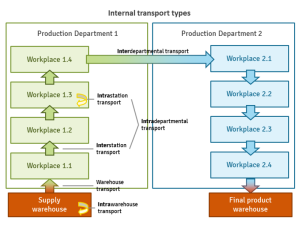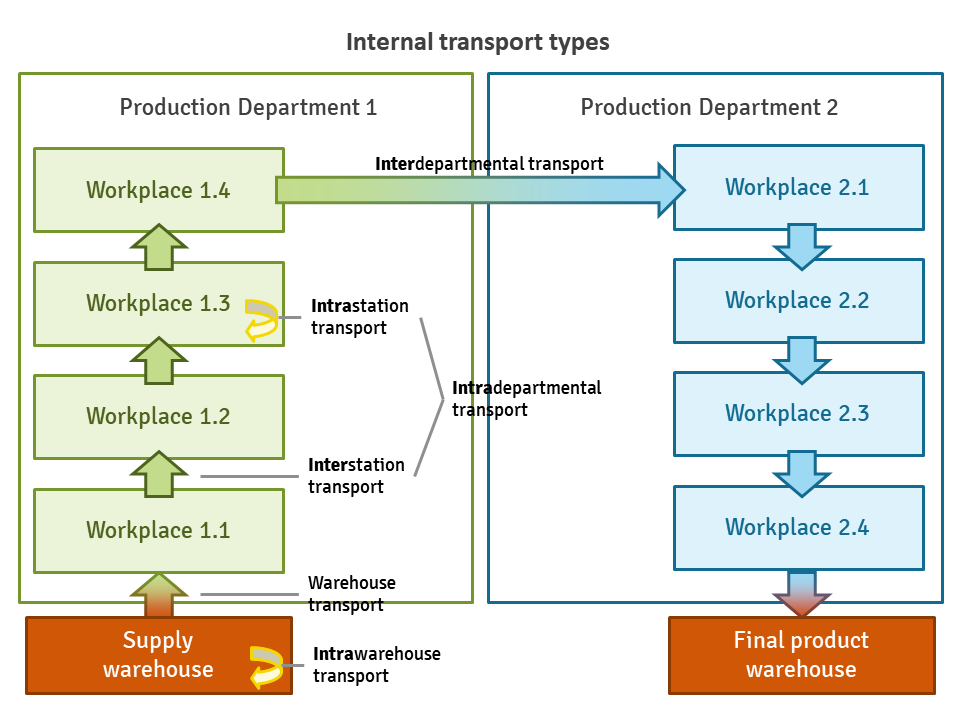Internal transport system
Technical means for handling and internal transport form a very important component of infrastructure of logistics. It actively contribute to the speed of movement of goods at the processes level, efficient handling and transport, at the same time providing a substantial degree of protection against damage and loss of value. Means of internal transport have a very important impact on the course of production processes. There are native means of manipulation and transportation:
- Machinery and transport equipment.
- Storage facilities
- Auxiliary equipment
The main transport devices in modern warehouses are:
- Industrial trucks
- Cranes,
- Conveyors
Special group includes automatic devices, manipulators and industrial robots. Storage devices are of different types:
- Joists
- Buckles
- Supports
- Stands
- Racks

Fig.1. Internal transport types
Among the storage racks we can distinguish:
- Sliding shelves - the working movement can be executed in parallel and perpendicular to the plane of load
- Circular shelves,
- Flow racks
- increase the use of warehouse area,
- decrease the carriage of goods within the warehouse,
- ensure the correct flow of goods in the warehouse.
Flow racks with drive set in the technological compact cause the elimination of transport routes. In combination with other cargo handling equipment such as conveyor, control devices allow for the introduction of process automation of storage. Additional equipment in racks, are:
- roller conveyors,
- fixed tiller,
- cranes
Auxiliary devices include:
- devices to facilitate loading of vehicles, such as:
- ramps,
- cargo bridges and countervailing
- movable ramps,
- Auxiliary equipment for storage and handling goods such as:
- palettes
- palletizers,
- pallet collars
- containers,
- yokes.
Each of these groups consists of a plurality of variants, classes and various models depending on the application. The choice of use of a specific system must take into account not only technical parameters, but also the opportunity to work in integrated systems.
Attention should also be paid to the costs, operational performance parameters, connection (synchronization) between partial flow and storage operations. This is a very comprehensive range of organizational and technical knowledge issues, related not only to the design and implementation but also the operation of the transport service systems in manufacturing processes.
Contents
- 1 Examples of Internal transport system
- 2 Advantages of Internal transport system
- 3 Limitations of Internal transport system
- 4 Other approaches related to Internal transport system
- 5 References
Examples of Internal transport system
- Automated Guided Vehicles (AGV): AGV is an automated transport system that uses electrically powered vehicles that move along pre-defined routes or paths, guided by markers, wires or lasers. AGV is used for handling and internal transport of goods, materials and supplies in the warehouse, distribution center and manufacturing unit.
- Conveyor Systems: Conveyor systems are an integral part of the internal transport system. It is used for the handling and transport of goods, material and supplies within the warehouse, distribution center or manufacturing unit. Conveyors are available in a variety of forms such as roller conveyors, belt conveyors, chain conveyors and pallet conveyors.
- Forklifts: Forklifts are used for the handling and transport of goods, materials and supplies within the warehouse, distribution center or manufacturing unit. They are designed to lift and move pallet loads, drums and other heavy items with ease. Forklifts are available in various load capacities and are powered by diesel, electric or propane.
- Tow Trucks: Tow trucks are used for the handling and transport of goods, materials and supplies within the warehouse, distribution center or manufacturing unit. They are designed to tow trailers, containers and other heavy items with ease. Tow trucks are available in various load capacities and are powered by diesel, electric or propane.
Advantages of Internal transport system
Internal transport systems have many advantages in the field of logistics. These include:
- Increased efficiency and speed of movement of goods as well as improved protection of goods against damage and loss of value. With the use of internal transport systems, goods can be moved quickly, safely and accurately to their destinations, reducing the amount of time and cost expended in the process.
- Improved safety, as internal transport systems are designed for specific purposes, allowing for a safer and more efficient handling and movement of goods.
- Improved space utilization, as internal transport systems can be designed to fit the needs of the particular operation. This reduces the amount of space required to store and move goods, resulting in increased efficiency and cost savings.
- Improved labor productivity, as internal transport systems are designed to allow for easier and more efficient handling of goods, which leads to improved labor productivity.
- Reduced environmental impact as internal transport systems are designed to reduce the amount of energy needed in the transportation process, thus resulting in reduced emissions and pollution.
Limitations of Internal transport system
- One of the major limitations of the internal transport system is the geographical constraints. This system is usually limited to a certain geographic area and thus cannot be used to transport goods to other parts of the world.
- Another limitation is the cost of the system. The cost of internal transport systems can be quite high, depending on the scale of the operation and the type of equipment used.
- The capabilities of the system may also be limited in terms of the types of goods that can be transported. Many systems are not designed to transport large or bulky items, or items that require special handling or storage.
- The speed of the system may also be limited, as many internal transport systems cannot reach the speeds necessary to transport goods quickly and efficiently.
- Finally, the system may be limited by the availability of personnel and resources. It may require the hiring of additional staff or the purchase of specialized equipment in order to make the system work properly.
In order to further improve the efficiency of internal transport system in logistics, a number of other approaches should also be taken into account. These include:
- Automation of processes - this involves the use of robots and other automated systems to reduce the time and effort required to move goods and materials from one place to another. It can also help reduce the risk of human error and the possibility of damage to goods.
- Use of specialized equipment - this includes the use of forklifts, pallet jacks, and other specialized equipment for handling and transporting materials. These machines can help reduce the amount of manual labor required and increase the speed of movement of goods.
- Improvement of existing infrastructure - this includes the improvement of existing roads, railways, and other infrastructure to reduce the time and effort required to move goods. This can also help reduce the amount of damage caused to goods during transport.
- Improved communication - this requires the use of modern technology, such as GPS and RFID tracking systems, to ensure that goods are moved in a timely manner and that their locations can be tracked easily.
In conclusion, the use of these approaches can help ensure that internal transport system in logistics is efficient, safe, and cost-effective. It can also help reduce the amount of time and effort required to move goods, leading to increased efficiency and productivity.
| Internal transport system — recommended articles |
| Storage and handling infrastructure — Receiving area — Principles for the warehouse organization — Tertiary packaging — Loose cargo — Transport infrastructure — Public warehouse — Organization of production — Batch picking |
References
- Garrido, R., & Allendes, F. (2002). Modeling the internal transport system in a containerport. Transportation Research Record: Journal of the Transportation Research Board, (1782), 84-91.

